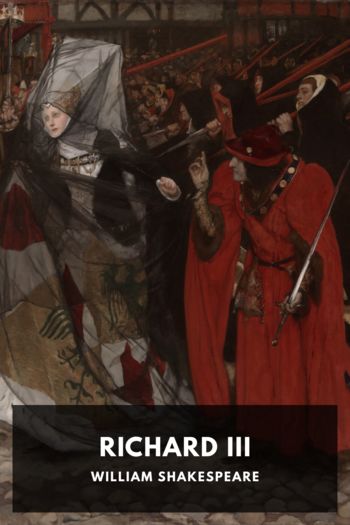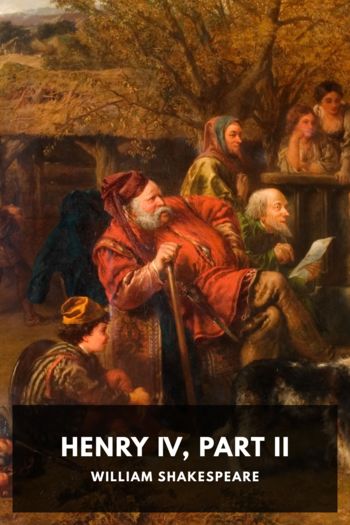Genre Other. Page - 277

Description
After the bloody battle at Tewksbury and the second dethroning of Henry VI, England and its citizens are finally able to enjoy peace under the reign of Edward IV. The remaining Lancastrian leaders are either killed or scattered to the four winds. Within the kingdom, not everyone is happy with their new king—and when Edward falls ill, his power-hungry brother Richard, the Duke of Gloucester, sees his chance and prepares to kill anyone who stands between him and the throne.
Richard puts into play numerous schemes to eradicate the line of succession and control the court. The first victim is King Edward’s other brother, Clarence. Rumors lead to Clarence’s imprisonment in the Tower of London, and Richard sends two murderers to stab him to death. This causes Edward’s health to worsen, and the title of Protector falls to the remaining brother. Next on Richard’s hit list is Lord Hastings, the loudest voice to object to Richard’s accession, and who is promptly arrested and executed for treason. As Richard orchestrates murder after murder, the deaths start coming back to haunt him.
This Standard Ebooks production is based on William George Clark and William Aldis Wright’s 1887 Victoria edition, which is taken from the Globe edition.

Description
The first three acts of Molière’s Tartuffe were first performed for Louis XIV in 1664, but the play was almost immediately suppressed—not because the King disliked it, but because the church resented the insinuation that the pious were frauds. After several different versions were written and performed privately, Tartuffe was eventually published in its final five-act form in 1669.
A comic tale of man taken in by a sanctimonious scoundrel, the characters of Tartuffe, Elmire, and Orgon are considered among some of the great classical theater roles. As the family strives to convince the patriarch that Tartuffe is a religious fraud, the play ultimately focuses on skewering not the hypocrite, but his victims, and the hypocrisy of fervent religious belief unchecked by facts or reason—a defense Molière himself used to overcome the church’s proscriptions. In the end, the play was so impactful that both French and English now use the word “Tartuffe” to refer to a religious hypocrite who feigns virtue.
In its original French, the play is written in twelve-syllable lines of rhyming couplets. Curtis Hidden Page’s translation invokes a popular compromise and renders it into the familiar blank verse without rhymed endings that was popularized by Shakespeare. The translation is considered a seminal by modern translators.

Description
Spargo, reporter extraordinaire for the Watchman, stumbles over a murdered man in London’s Middle Temple Lane, and, based on a journalistic hunch, decides to investigate. As the circle of interest widens, strange connections start to emerge; connections that lead towards an unsuspected conspiracy of twenty years before.
The Middle Temple Murder is one of the prolific J. S. Fletcher’s most popular works. It builds on his earlier short story “The Contents of the Coffin,” and was published in 1919 as one of three novels he wrote that year. President Woodrow Wilson publicly praised the work, which helped Fletcher earn U.S. acclaim and eventually a publishing deal.

Description
The essential facts regarding Joan of Arc are well known. A young teenage girl hears voices that tell her she will deliver France from England’s oppression during the Hundred Years War. She manages to take her message to the dauphin, who after some persuasion places her at the head of his army. That army promptly lifts the siege of Orléans, throws the English out of the Loire valley, hands them another significant defeat at Patay, and marches all the way to Reims, where the dauphin is crowned King Charles VII. After an ill-advised and short-lived truce, Joan is captured by the Burgundians—French nobility who have aligned themselves with the English—and they try her for heresy and burn her at the stake.
Twain first became fascinated with Joan as a teenager. When he finally decided to write a book about her, he researched it for a dozen years and spent two more years writing it. It was, in his words, “the best of all my books,” and became his last finished novel. Although a work of fiction, Twain’s research was time well spent: the known facts of Joan’s life, and especially the trial, are very accurate in their depiction. To tell Joan’s story, Twain invented a memoirist, Louis de Conte, a fictionalized version of her real-life page, Louis de Contes. Twain has the fictional de Conte grow up with Joan, and so he is able to tell her story from her early childhood all the way through the trial and execution. The result is the story of one of the great women in history told by one of history’s great storytellers.

Description
Thus Spake Zarathustra was Friedrich Nietzsche’s favorite of the books he wrote, and has been his most popular amongst general readers. Yet some scholars dislike it because of its unphilosophical nature: it eschews jargon and the scaffolding of arguments, which engage only the intellect, in favor of an artistic approach that engages the whole mind.
After ten years of solitude in a cave high in the mountains, Zarathustra wishes to share with humanity the wisdom he has accumulated during this time. He reaches the nearest town and addresses the crowd on the marketplace. He tells them of the Overman: the next step in human evolution, a being who creates their own values, freed from the weight of tradition and morality, and who takes responsibility for their own successes and failures. But the crowd doesn’t understand him; his discourse is met only with rude ignorance. Zarathustra then decides to gather a small group of disciples and share his wisdom with them.
The bulk of the book is Zarathustra’s speeches on topics such as morality, society, individualism, religion, and how suffering and its overcoming are what give meaning to our existence. While already wiser than most, Zarathustra still learns from those he talks to, re-evaluating his thoughts as he deals with disappointment (such as when his disciples prove to be mere followers), and confronting his own doubts. His greatest challenge, though, comes when he faces the existential test of the eternal recurrence of the same: the thought that our lives could repeat indefinitely without the minutest of change.
The inspiration for Zarathustra came to Nietzsche during one of the long hikes he often indulged in despite his failing health. It was a decade of solitude: his physical condition had worsened to the point of forcing him to retire from his position at the University of Basel, and each change of season prompted him to relocate to kinder climes in Switzerland, France, or Italy. The book took two years to write. Each of its four parts was written in a ten-day period of creative effervescence followed by months of gloom, plagued by terrible, debilitating migraines.
Zarathustra was initially received with indifference at best and frustration at worst. It’s a work of philosophy as much as aesthetics: the language is modeled after the Luther Bible and contains numerous references to Homer, Heraclitus, Plato, Goethe, Emerson, and Wagner, to name a few. Later Nietzsche attempted to address the book’s lack of popularity by framing the same concepts in a more traditional, approachable manner in his following book, Beyond Good and Evil, but that book also struggled to find an audience.
With his health steadily deteriorating, Nietzsche’s mind broke down in 1889 and never recovered. His body would live on for 11 more years, and he ended up in the care of his sister, Elisabeth. A stalwart nationalist and anti-Semite, she saw in her brother’s illness the opportunity to turn him into a German hero. Despite her brother’s firm opposition to nationalism, anti-Semitism, and power politics, she perverted his work by promoting it for her own ends. Scores of commentators partook in her lie and enthusiastically used Nietzsche’s work to buttress their own contrary views. Doing so requires one to selectively ignore half the content of the book: Zarathustra’s discourses regularly touch on a priori dark and violent themes, but they also clearly state that these are to be directed towards oneself. Reaching the Overman requires us to know ourselves, and such introspection, given the darker side of human nature, leads to contempt. This contempt for ourselves, says Nietzsche, should be embraced as the first step towards awareness of what we could be. Cruelty, likewise, stems from that knowledge as a necessity to hammer ourselves into the proper shape. Such commentators also conveniently ignored Zarathustra’s many remarks about love: love for ourselves, he says, is what can prevent us from spreading resentment around us during this difficult process of change.
The first English translation of Zarathustra was by Alexander Tille, a German scholar who had emigrated to Scotland. English wasn’t his first language and his work suffered from it. Thomas Common, a Scottish scholar, used Tille’s work as the base for his own translation. Bringing Zarathustra to the English-speaking world was no easy task given Nietzsche’s stylistic idiosyncrasies. Just like Nietzsche, Common took risks: because the book is written in the style of the Luther Bible, Common decided to emulate the style of the King James Bible; he also tried to reproduce the musicality of the language and the new words coined by Nietzsche, some of which have been updated over time—e.g. Common’s “Superman” is nowadays known as “Overman.” While his choices have been controversial, he produced a landmark translation that faithfully tried to convert the unique flavor of Zarathustra into English. Published in 1909, it would take four decades until the next translation by Walter Kaufman in 1954.
But Zarathustra didn’t find its scholarly fame limited to Europe: soon after its publication, it reached Asia, where it was received with enthusiasm, particularly in China and Japan where it influenced the famous Kyoto School. Zarathustra has also received special attention from the music world. Nietzsche loved music and poetry, and it was his wish that this book be taken as music. No fewer than 87 pieces have been inspired by the book, in part or as a whole. The best known are Richard Strauss’ Also Sprach Zarathustra, the fourth movement of Gustav Mahler’s Symphony No. 3, and Frederick Delius’ A Mass of Life.

Description
The Imitation of Christ is a Christian devotional book dating to the early 15th century, originally written anonymously but popularly attributed to Thomas à Kempis. A popular piece of religious literature since it was first circulated, the Imitation is divided into four books that instruct the reader to forego worldly goods, to follow Christ, and to receive the sacrament of Communion, all in order to attain spiritual peace. Admired by numerous Christian theologians and mystics throughout the course of centuries, it is today considered to be the most-read Christian devotional work besides the Bible, going through over 745 printings before 1650. The Imitation even found an audience in India with the 19th-century Hindu philosopher-monk Ramakrishna, who cherished it along with the Bhagavad Gita as one of his favorite books.

Description
An Antarctic Mystery follows Mr. Jeorling, a wealthy American naturalist whose research has led him to the remote Kerguelen Islands, located in the southern Indian Ocean. Jeorling begins his adventure on the Halbrane after being admitted aboard by the reluctant captain Len Guy, who believes the events in The Narrative of Arthur Gordon Pym to be true. In that novel, Pym persuades Len Guy’s brother, William Guy, to lead a voyage to the Antarctic. But the expedition ends in failure when William Guy, his crew, and his ship, the Jane, disappear under mysterious circumstances. Captain Len Guy convinces Jeorling to aid in the search for his brother, and the two embark on an expedition south to the Antarctic in search of the previous voyage’s survivors.
Despite the fact that Jules Verne’s work was published over fifty years after Pym, the events in the novel take place only one year after the disappearance of the Jane.

Description
Lavengro, the Scholar, the Gypsy, the Priest, published in 1851, is a heavily fictionalized account of George Borrow’s early years. Borrow, born in 1803, was a writer and self-taught polyglot, fluent in many European languages, and a lover of literature.
The Romany Rye, published six years later in 1857, is sometimes described as the “sequel” to Lavengro, but in fact it begins with a straight continuation of the action of the first book, which breaks off rather suddenly. The two books therefore are best considered as a whole and read together, and this Standard Ebooks edition combines the two into one volume.
In the novel Borrow tells of his upbringing as the son of an army recruiting officer, moving with the regiment to different locations in Britain, including Scotland and Ireland. It is in Ireland that he first encounters a strange new language which he is keen to learn, leading to a life-long passion for acquiring new tongues. A couple of years later in England, he comes across a camp of gypsies and meets the gypsy Jasper Petulengro, who becomes a life-long friend. Borrow is delighted to discover that the Romany have their own language, which of course he immediately sets out to learn.
Borrow’s subsequent life, up to his mid-twenties, is that of a wanderer, traveling from place to place in Britain, encountering many interesting individuals and having a variety of entertaining adventures. He constantly comes in contact with the gypsies and with Petulengro, and becomes familiar with their language and culture.
The book also includes a considerable amount of criticism of the Catholic Church and its priests. Several chapters are devoted to Borrow’s discussions with “the man in black,” depicted as a cynical Catholic priest who has no real belief in the religious teachings of the Church but who is devoted to seeing it reinstated in England in order for its revenues to increase.
Lavengro was not an immediate critical success on its release, but after Borrow died in 1881, it began to grow in popularity and critical acclaim. It is now considered a classic of English Literature. This Standard Ebooks edition of Lavengro and The Romany Rye is based on the editions published by John Murray and edited by W. I. Knapp, with many clarifying notes.

Description
Claude Wheeler is the son of a successful Nebraskan farmer and a very devout mother. He’s sent to a private religious college because his mother feels it’s safer, but he yearns for State college where he might be able expand his knowledge of the real world. Claude doesn’t feel comfortable in any situation, and almost every step he takes is a wrong one. While he’s struggling to find his way in a questionable marriage, the U.S. decides to enter World War I, and Claude enlists. He’s commissioned as a lieutenant, and he and his outfit are deployed to France in the waning months of the war. There Claude finds the purpose he’s been missing his whole life.
One of Ours is Cather’s first novel following the completion of her Prairie Trilogy, which she finished before the U.S. had entered the war. Cather’s cousin Grosvenor had grown up on the farm next to hers, had many of the traits she gave to Claude, and, like her protagonist, went with the Army to France towards the end of the war. After the war was over, she felt compelled to write something different than the novels she had become known for, saying that this one “stood between me and anything else.” Although today it’s not considered her best work, the novel won the Pulitzer Prize for Fiction in 1923.

Description
As the dust settles on the battlefield at Shrewsbury, news spreads that the rebel forces fighting against King Henry IV have suffered a terrible defeat. Their leader, Harry “Hotspur” Percy, was killed by Prince Hal. The rebel troops quickly abandon the fight after seeing their leader die. Two powerful cohorts, the Earl of Worcester and Douglas, are taken as prisoners by the King’s men. The Earl of Northumberland vows to avenge his son’s death and plans to seek support from the Archbishop of York.
Meanwhile, the Archbishop has convened his group of allies—Thomas Mowbray, Lord Hastings, and Lord Bardolph—to plan the next battle against King Henry. If they want a chance of winning, they fight on three separate fronts: one to fight King Henry’s forces, one to fight the Welsh rebels led by Owen Glendower, and one to maintain the fight in France. They decide to follow this plan regardless of whether or not Northumberland lends them his army.
As the Prince’s merry team of misfits return to London, Falstaff continues to create mischief wherever he goes. After hearing that his father has fallen sick, Hal starts to regret the days when he used to drink and steal with Falstaff. If he is to be the next king, he must leave behind his past along with his partners in crime.
This Standard Ebooks production is based on William George Clark and William Aldis Wright’s 1887 Victoria edition, which is taken from the Globe edition.